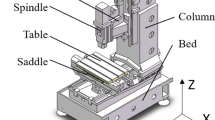Abstract
The dynamic performance of the grinding machine spindle determines its ultimate vibration resistance and the machining accuracy. To gain better dynamic performance of the grinding machine spindle system, the integrated evaluation and optimization method should take both manufacturing process and machine tool into account. In this paper, a frequency domain dynamic response approach is proposed to study the optimization. This approach considers the dynamic grinding force from the view of spindle imbalance and frequency response function (FRF) by means of modal frequency and dynamic stiffness. The dynamic grinding force is analyzed experimentally to verify the vibration excitation force in process. Furthermore, the optimization process by finite element method is conducted with the intermediate dynamic parameter improvement by structural optimum design. Applying on a high-speed machine tool, the case studies are illustrated to demonstrate the implementation of the proposed method; the dynamic response optimization approach results shows, to achieve the vibration response in grinding process, it is necessary and priority to improve the dynamic stiffness of the spindle.
Similar content being viewed by others
References
Abele E, Altintas Y, Brecher C (2010) Machine tool spindle units. CIRP Ann Manuf Technol 59(2):781–802
Wang X, Yu T, Dai Y, Wang W (2016) Kinematics modeling and simulating of grinding surface topography considering machining parameters and vibration characteristics. Int J Adv Manuf Technol 87(9–12):2459–2470
Inasaki I, Karpuschewski B, Lee HS (2001) Grinding chatter—Origin and suppression. CIRP Ann 50(2):515–534
Qin Y, Brockett A, Ma Y, Razali A, Zhao J, Harrison C, Pan W, Dai X, Loziak D (2010) Micro-manufacturing: research, technology outcomes and development issues. Int J Adv Manuf Technol 47(9–12):821–837
Rebelein C, Vlacil J, Zaeh M (2017) Modeling of the dynamic behavior of machine tools: influences of damping, friction, control and motion. Prod Eng 11(1):61–74
Zaeh M, Siedl D (2007) A new method for simulation of machining performance by integrating finite element and multi-body simulation for machine tools. CIRP Ann Manuf Technol 56(1):383–386
Lin CW, Jay FT, Joe K (2003) An integrated thermo-mechanical-dynamic model to characterize motorized machine tool spindles during very high speed rotation. Int J Mach Tools Manuf 43(10):1035–1050
Wu Z, Li B, Yang J, Sheng X (2013) A thermodynamics coupled modeling approach for analysis and improvement of high-speed motorized spindle system. J Vibroengineering 15(3):1119–1129
Fredin J, Jönsson A, Broman G (2012) Holistic methodology using computer simulation for optimisation of machine tools. Comput Ind Eng 63(1):294–301
Wu B, Young G, Huang T (2000) Application of a two-level optimization process to conceptual structural design of a machine tool. Int J Mach Tools Manuf 40(6):783–794
Altintas Y, Cao Y (2005) Virtual design and optimization of machine tool spindles. CIRP Ann Manuf Technol 54(1):379–382
T. Li, X. Ding, K. Cheng, T. Wu (2017) Dynamic optimization method with applications for machine tools based on approximation model. ARCHIVE Proc Inst of Mech Eng C J Mech Eng Sci 1989-1996(203–210)
Huo D, Cheng K, Wardle F (2010) A holistic integrated dynamic design and modelling approach applied to the development of ultraprecision micro-milling machines. Int J Mach Tools Manuf 50(4):335–343
Neugebauer R, Ihlenfeldt S, Frieß U, Wabner M, Rauh S (2012) New high-speed machine tool structure by holistic mechatronic systems design. Proc CIRP, 1(1):307–312
Aggogeri F, Merlo A, Mazzola M (2010) Multifunctional structure solutions for ultra high precision (UHP) machine tools. Int J Mach Tools Manuf 50(4):366–373
Xu Y et al (2017) Dynamic optimization of constrained layer damping structure for the headstock of machine tools with modal strain energy method. Shock Vib 2017:1–13
Oliveira JFG, França TV, Wang JP (2008) Experimental analysis of wheel/workpiece dynamic interactions in grinding. CIRP Ann Manuf Technol 57(1):329–332
Govekar E, Baus A, Gradišek J, Klocke F, Grabec I (2002) A new method for chatter detection in grinding. CIRP Ann Manuf Technol 51(1):267–270
González-Brambila O, Rubio E, Jáuregui JC, Herrera-Ruiz G (2006) Chattering detection in cylindrical grinding processes using the wavelet transform. Int J Mach Tools Manuf 46(15):1934–1938
E. Kushnir, T. Sheehan (2003) Development of machine tool structure at the early stages of design process. ASME 2003 International Mechanical Engineering Congress and Exposition, Washington, DC, November, 470: 121–127
Brecher C, Esser M, Witt S (2009) Interaction of manufacturing process and machine tool. CIRP Ann Manuf Technol 58(2):588–607
Guo M, Li B (2016) A frequency-domain grinding force model-based approach to evaluate the dynamic performance of high-speed grinding machine tools. Mach Sci Technol 20(1):115–131
Guo M, Li B, Ding Z, Liang SY (2016) Empirical modeling of dynamic grinding force based on process analysis. Int J Adv Manuf Technol 86(9–12):3395–3405
Acknowledgements
This project is supported by Shanghai Sailing Program (No.18YF1418400) and Natural Science Foundation of China (No. 50975046).
Author information
Authors and Affiliations
Corresponding author
Rights and permissions
About this article
Cite this article
Guo, M., Jiang, X., Ding, Z. et al. A frequency domain dynamic response approach to optimize the dynamic performance of grinding machine spindles. Int J Adv Manuf Technol 98, 2737–2745 (2018). https://doi.org/10.1007/s00170-018-2444-5
Received:
Accepted:
Published:
Issue Date:
DOI: https://doi.org/10.1007/s00170-018-2444-5



